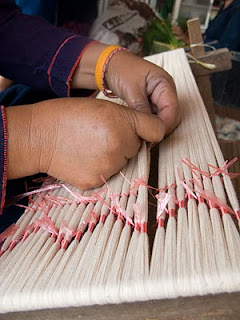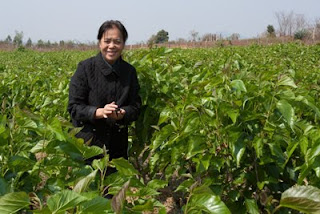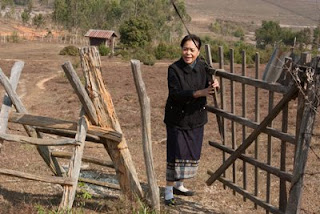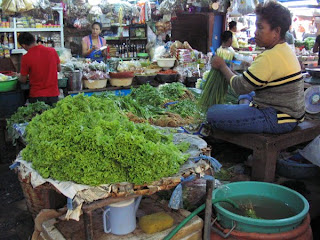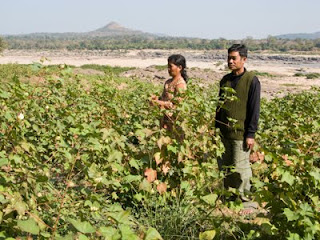We're thrilled to post this article about the philosophy of
Slow Fashion and its connection to the Slow Food movement by guest blogger Pam Johnston. Pam is a recent graduate of the Nova Scotia College of Art and Design in Halifax, Nova Scotia, Canada, with a bachelor of fine arts (major in textiles and minor in fashion). She is an active member of the Clothing and Textile Action Group at Nova Scotia's
Ecology Action Centre. Photos by TAMMACHAT's co-founder, Ellen Agger. [Citations at the end of this article.]
__________________________________________________
IntroductionThe summer of 2005 was a turning point in my life. During a trip to Vietnam I saw something beautiful that was missing from my experience of Canadian urban and suburban culture.
Each morning, before 5 a.m. farmers from surrounding regions brought fresh produce to the city center of Ha Noi to be sold at markets. Each day locals went to the market to select goods for their day’s meals. The market was filled with herbs, flowers, vegetables, fruits, eggs, meats, and fish I had never seen before. And the people used everything well.
For example, every part of banana trees was used. Banana fruit was eaten, banana leaves were used to wrap steamed sticky rice, and banana tree trunks were sliced thinly and used as garnish for hot dishes. The foods there were fresh, local, traditional and unique to their country—and the flavour was out of this world!
Market vendor in neighbouring Thailand
It was after returning to Nova Scotia from Vietnam that I experienced a fresh hunger to know what types of produce and traditional recipes were unique to Nova Scotia. I wanted to know who grew and prepared the food I was consuming, and to feel as connected to the place I lived as the people in Vietnam appeared to be.

My trip to Vietnam and many subsequent trips to the farmer’s market have taught me that getting the most out of my dollar does not necessarily mean getting more items faster. Sometimes it means getting more quality. Bess Nielson once said, "true luxury is that which gives as much to one’s spirit as it does to one’s material needs" (Selvedge 79). Buying food from Superstore does something to fill my material needs. But buying goods from the farmer’s market allows me the opportunity to support local businesses, enjoy the creativity of local, independent artisans and meet them face-to-face. This meets my material needs as well as my spiritual needs for community, connection and contribution.
Recently the Slow Food movement has gained recognition and influence across the globe. In the mid-1980s Slow Food was born in opposition to the proliferation of "identical, repeated, predictable" fast food (Sterling 112). Alice Waters, in her foreword to Carlo Petrini’s book
Slow Food: The Case for Taste, poignantly summarizes the key principles held up by the movement, and the impact they can have on one’s thinking and everyday experience:

Under Carlo’s remarkable leadership, Slow Food has become a standard bearer against the fast-food values that threaten to homogenize and industrialize our food heritage. Slow Food reminds us that our natural resources are limited, and that we must resist the ethic of disposability that is reflected everywhere in our culture. Slow food reminds us that food is more than fuel to be consumed as quickly as possible and that, like anything worth doing, eating takes time. Slow Food reminds us of the importance of knowing where our food comes from. When we understand the connection between the food on our table and the fields where it grows, our everyday meals can anchor us to nature and the place where we live. And Slow Food reminds us that cooking a meal at home can feed our imaginations and educate our senses. For the ritual of cooking and eating together constitutes the basic element of family and community life (Petrini ix-x).
The principles described here—preservation of cultural diversity, wise use of natural resources, allowing time for creation and enjoyment, connecting product with raw material and producer, and working in community—have deep relevance to patterns of production and consumption of all objects, including clothing.
In this essay I compare "fast fashion" to fast food, and examine how conventional fast fashion practices today have led us to a critical point of decision. The damaging effects of wasteful consumption on Earth, and the uniformity that globalizes fast fashion produces leave us yearning for an approach to fashion that has more integrity, endurance, and meaning. In the same way that Slow Food arose to build sustainable alternatives to careless, frenzied eating habits, the Slow Fashion movement provides viable alternatives to cheap, speedy, image-based fashion. It calls us to give care, attention and intention to our fashion purchases. It calls us to be creative and work within limited resources, leaving behind the attitude that more and bigger are always better.
The Problem of Fast FashionWhen you think "fast fashion" you can think disposable, short-lived and cheap; seasonal change, image glorification, and mass marketing; mass production, quantity, standardization, and identical product; mediocre quality, lack of meaning and value; and international acceptance and global homogenization. These are the qualities that characterize fast fashion, and for many North Americans it is the only type of fashion they know.

Fast fashion has been made possible in our generation by a number of factors. According to Sarah Scatturo, one of the main factors is "the perfection of networked technological systems streamlining the design, manufacturing, and consumption of clothing" (Scaturro 469-88). Also, the development of man-made fibres and genetically modified fibre crops have enabled textile producers to push the limits of the land’s natural capacity as well as bypass more labour-intensive, time-consuming natural fibre processing procedures in order to meet growing demands for clothing. In addition, the lifting of import quotas in January of 2005 (in accordance with the World Trade Organizations Agreement on Textiles and Clothing) allows inexpensive foreign imports to flood once-protected markets in Canada and the US, in turn increasing competitiveness among manufacturers (Industry Canada 4). Advancements in global communications have made way for fast, effective global marketing strategies, resulting in fleeting fashion images and trends being disseminated to all ends of the earth.
As a result, much of the Western world has an increasingly insatiable lust and ability to buy more clothing than ever before. According to Sandy Black’s investigation into this issue, "Relative to income, clothes are now far cheaper than they were a few decades ago. Clothing sales have increased by 60 percent in the last ten years. We now consume one third more clothing than even four years ago…and discard it after wearing just a few times or indeed, even once" (Black 14).
In the same way problematic fast-food values are manifested in the North American obesity pandemic, the consequences of fast fashion gluttony are becoming increasingly evident. For example, in the UK, 30 kilograms of textile and clothing waste per person is dumped in the landfill each year! (Collet 18). There are also the problems of sickness and death resulting from the use of pesticides on conventional cotton crops, water pollution and damaged ecosystems from textile manufacture waste, and a great deal of energy and water used to make and care for an overabundance of clothing (Scatturo 469-88).
Farmers in Thailand grow organic cotton
along the banks of the Mekong River
In addition to the burden on the planet and the resulting illnesses for those in polluted areas, fast fashion takes a toll on the factory workers who must meet high demands for output. We have all heard sad stories of workers being extremely underpaid and overworked to meet the demands of massive global retailers. Thanks to trade liberalization, this pressure is now not only felt by overseas workers but also by Canadian manufacturers, as they struggle to compete in the global manufacture market (Industry Canada 5). The Earth and its people are groaning under this weight of injustice and greed.
An Opportunity to CelebrateSituations like this inevitably dampen our spirits. However, there are two kinds of sorrow: one that leads to death, and one that leads to repentance. The first type despairs, seeing no future, no hope and no opportunity for change. The second type acknowledges what is wrong and turns around to walk in the other direction, celebrating the opportunity to change, and looking beyond the situation towards the potential.
Slow Fashion is like the brave soul who leaves the masses on their wide, smooth dead-end highway to march steadily along a narrow, difficult path to a bright future. In Grace Cochrane’s article "Australia and New Zealand: Design and the Handmade" she states that businesses working on a smaller scale have the option of "offer[ing] something that is of higher value and produced in smaller runs that reach a particular discerning market both at home and elsewhere". She goes on to say that while the "game is hard", it is also "often rewarding and distinctive" (Alfoldy 64). Many advocates of Slow Fashion are small enterprises and, though their position is tough in light of powerful and vast retailers, I am convinced that they have an essential and influential role to play. The success of the Slow Food movement gives us hope, and at this point I would like to parallel the two movements by adapting the principles quoted earlier:
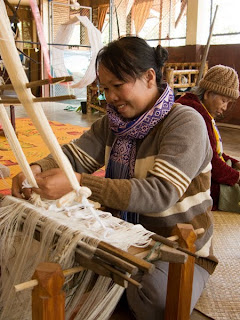
Under the leadership of brave designers, Slow Fashion has become a standard bearer against the fast-fashion values that threaten to homogenize and industrialize our fashion heritage. Slow Fashion reminds us that our natural resources are limited, and that we must resist the ethic of disposability that is reflected everywhere in our culture. Slow Fashion reminds us that fashion is more than image to be consumed and changed as quickly as possible and that, like anything worth doing, creating valuable vestments takes time. Slow Fashion reminds us of the importance of knowing where our clothes come from. When we understand the connection between the clothes on our backs and the fields where fibre grows and the studios where fabric is shaped and embellished, our everyday clothing anchors us to nature and the place where we live. And Slow Fashion reminds us that participation in the design process can feed our imaginations and educate our senses (author’s adaptation of Alice Water’s foreword in Petrini ix-x).
Slow Fashion responds to the problems of fast fashion by offering an alternative approach to design, production and consumption. When you think Slow Fashion, you can think value, quality, and craftsmanship; creativity within limitations, versatility, and personalization; staying power, heirloom quality, and extended life span; transparent production systems, regional and traditional craft skills, and collaboration.

Various designers exemplify these values in differing ways. Some extend the lifecycle of existing damaged or unloved garments by redesigning or custom fitting. Others make use of localized cooperatives that offer high-quality handwork and innovative applications of traditional craft skills. Some incorporate recycled or reclaimed fabrics into couture-type designs, while others use new materials to create long-lasting garments that can be worn in different ways by people of varying sizes and genders. Some work in collaboration with the end user by personalizing designs through colour or fabric choice, unique embellishments or perfect fitting. Sandy Black sums up the ethos simply: "buying long-lasting craftsmanship, highest quality and unique items means they will be treasured for a long time, becoming heirlooms of the future, and contributing to a lower rate of consumption" (Black 79).

If you are like me, you might still ask yourself how this type of business could actually survive—and could it thrive? —in today’s consumerist society. If the success of the Slow Food movement is any indicator, then Slow Fashion will survive and grow through tenacious, innovative designers networking to share knowledge, to infiltrate conventional fashion institutions and to educate others. Because of the very nature of Slow Fashion, the businesses that adhere to its principles will not grow to become massive global retailers. As Bruce Sterling put it in his article "The Revenge of the Slow", a local product with "irreducible rarity" can only be sold to a select few across the globe, and not to the masses, as its production cannot be scaled up (Sterling 114-116). Slow Fashion designers instead need to unite their disparate niches through cultural networking (Sterling 116). The Internet is a valuable tool in this regard. It is also a way designer-makers can educate the public, provide transparency about their production methods, allow consumers to collaborate, and sell directly to consumers without the mediation of retailers.
ConclusionSlow Fashion is a baby movement, having been born of the Slow Design movement just within this decade. Its growth hinges on a shifting of heart and attitude towards the way we consume clothing—from an attitude of carelessness, ignorance and waste to one of stewardship, intention and pleasure in simple, valuable everyday experiences. This shift will take time and effort, but through steadfast commitment on the part of designer-makers and educators awareness will grow. My hope is that people will be so enamored with the beauty and virtue of Slow Fashion’s principles and product that they will forget about the less satisfying alternative of fast fashion.
__________________________________________________
Works CitedAlfoldy, Sandra, ed. NeoCraft: Modernity and the Crafts. Halifax: The Press of the Nova Scotia College of Art and Design, 2007.
Black, Sandy. Eco-Chic: The Fashion Paradox. London, UK: Black Dog Publishing, 2008.
Clark, Hazel. "Slow + Fashion—an Oxymoron—or a Promise for the Future…?" Fashion Theory. Vol. 12, No. 4, pp. 427-446. December 2008.
Collet, Carole. "The Next Textile Revolution". Responsive Textile Environments. Ed. Sarah Bonnemaison and Christine Macy. Halifax: TUNS Press, 2007.
Industry Canada. A Canadian Approach to the Apparel Global Value Chain. Prepared by Milstein & Co Consulting Inc. March 2008.
Petrini, Carlo. Slow Food: The Case for Taste. Trans. William McCuaig. New York: Columbia University Press, 2001.
Scaturro, Sarah. "Eco-Tech Fashion: Rationalizing Technology in Sustainable Fashion". Fashion Theory. Vol. 12, No. 4, pp. 469-88. December 2008.
Sterling, Bruce. "Revenge of the Slow". Metropolis. Vol. 27, No. 8, pp. 112-116. March 2008.














